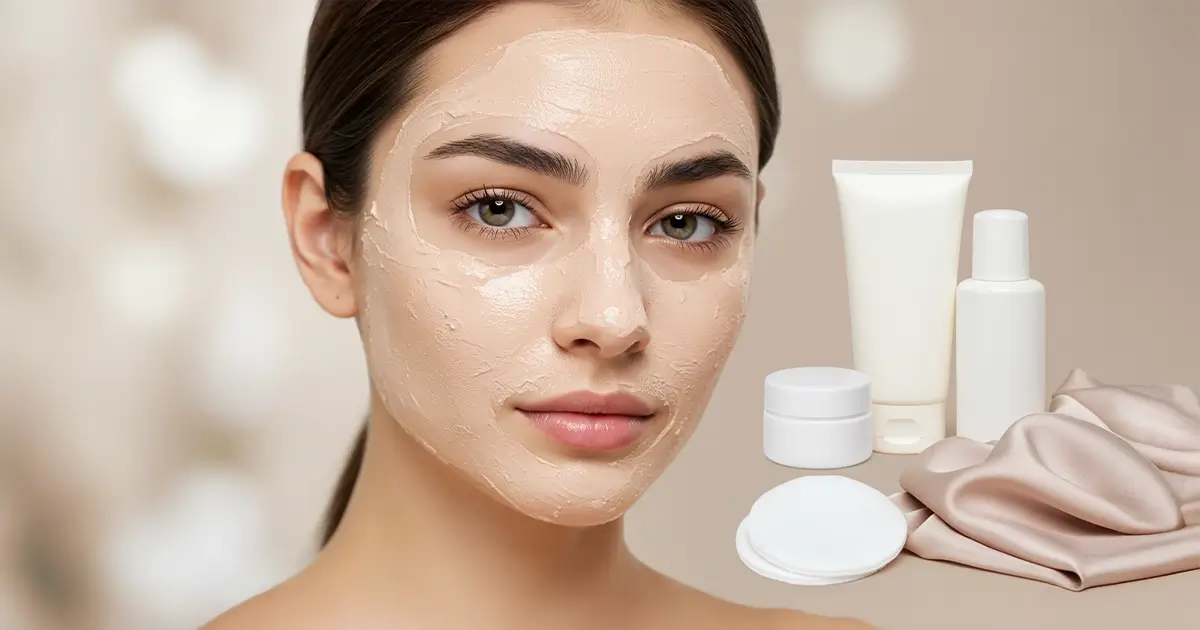Maskne - the cheeky mash-up of "mask" and "acne" - turns an everyday safety measure into a stubborn skincare puzzle. Today I unpack why those red bumps crop up under your protective gear and exactly how to keep your complexion calm while still masking responsibly.
The Science Behind Maskne
The skin that lives beneath a snug face mask is suddenly trapped in its own little greenhouse. Heat rises with every exhale, humidity climbs, and pores swell like overheated sponges craving fresh air. That warm, moist setting lets Cutibacterium acnes and friends multiply quickly so blocked follicles erupt into clusters of tiny whiteheads and inflammatory papules.
Occlusion does more than raise the thermostat. Mask fabric rubs repeatedly against cheeks and jawline acting like sandpaper that wears away corneocytes and forces keratin deeper into ducts. Dermatologists call this acne mechanica, once common in athletes wearing tight helmets and now familiar to anyone commuting on the subway.
Stress adds an invisible layer. Cortisol surges during long workdays, boosting sebaceous gland output precisely where sweat and dead cells are already jammed. Mix in leftover makeup and you have a perfect storm that sends inflammatory signals racing across the lower half of your face.
Humidity and pH Shifts
Humidity does more than amplify shine, it changes the surface pH by almost half a unit. Higher pH encourages opportunistic bacteria while weakening the lipid matrix that normally keeps moisture locked in, so skin swings between soggy and stripped which ironically leads to more oil production as it tries to self-correct.
Visible Clues Across Skin Tones
Symptoms show up differently on various tones. On darker complexions maskne can look like dusky post-inflammatory spots that linger long after the bump calms, whereas on fair skin it goes red and shiny. Tailoring treatment intensity to the lingering mark is key.
Fabric and Fit: Choosing Mask Materials
Not every face covering is created equal when it comes to breakouts. Synthetics like polyester trap heat and sebum, while tightly woven cotton or silk blends let moisture escape and reduce friction on delicate skin. I switched to a three-layer cotton inner panel last winter and watched my chin calm down within a week.
Construction counts too. A flexible nose wire stops warm breath from billowing up toward your eyes and down toward your jaw, preventing condensation pockets that would otherwise sit on pores all morning. Ear loops with adjustable sliders keep straps from digging in so pressure bumps never get the chance to form.
If you need to wear a mask longer than four hours, pack spares the way marathoners pack energy gels. Trading a damp cover for a fresh one halfway through the day feels like opening a window on your face. Store clean backups in paper envelopes to avoid the humid handbag trap.
A mask that rides up and down your nose wipes off sunscreen and leaves a smear of sweat behind; that smear is a breeding ground. Adjust the nose wire snugly then anchor the side panels with clips so nothing shifts, even when you do.
How to Launder Masks for Clear Skin
Wash reusable masks after every wear, preferably in hot water over sixty degrees Celsius to kill microbes. Use fragrance-free, hypoallergenic detergent because lingering perfume molecules can irritate compromised skin, then air-dry completely since damp fabric becomes a bacterial hostel.
Do Fabric Dyes Matter?
Dyes matter. Deeply pigmented fabrics sometimes shed small dye molecules that mix with sweat and penetrate follicles causing irritant dermatitis that masquerades as acne. Stick to natural, lighter hues if your skin is acting temperamental.
- Three-layer construction with a moisture-absorbing inner cotton layer
- Adjustable ear loops to fine-tune tension
- Structured shape that stands off the mouth to improve airflow
- Replaceable filter pocket for pollution-heavy days
- Seamless inner surface to prevent pressure marks
Daily Routine Tweaks for Clear Skin
My morning routine is deliberately boring because boring works. I wash with a sulphate-free gel at lukewarm temperature, pat dry with a soft towel, then pat on a pea-sized blob of lightweight moisturizer to create a breathable buffer between skin and fabric. Skip foundation below the mask because creamy pigments mix with sweat and close off follicles faster than you can say breakout.
Halfway through the day I perform a stealth cleanse in the restroom. A fragrance-free micellar wipe lifts oil without stripping lipids and gets me back to a smooth canvas before I swap masks. It looks extra but takes ninety seconds, tops, and beats frantically booking an extraction later.
Evening rules are non-negotiable. I double cleanse: first micellar to dissolve sunscreen, then an acid-balanced foam to sweep away particulate dust. Finally I lay down a barrier cream rich in ceramides so micro tears from friction repair overnight.
If a midday cleanse isn't possible, a spritz of thermal water followed by blotting with a clean tissue keeps salt crystals from sitting on the surface until you get home. It's the desk drawer secret no one regrets adding.
Once you safely remove your mask at home, treat the area like post-workout skin: cleanse gently, pat dry, then apply a calming serum with centella or panthenol. Those ingredients dial down micro-inflammation so tomorrow you start fresh.
- Start with a gentle, sulfate-free cleanser and lukewarm water, patting dry instead of rubbing.
- Smooth on a lightweight, non-comedogenic moisturizer to reduce friction and act as a buffer.
- Skip foundation under the mask, or switch to mineral tints; creamy formulas melt, mix with sweat, and block pores.
- Swap the mask every four hours if you speak a lot or sweat heavily, and at least every day even if it looks clean.
- Fold used masks inner sides together to avoid contaminating surfaces.
- Rotate between at least three cloth masks so one is always freshly laundered.
- Keep a travel-size moisturizer to re-apply if skin tightens after long phone calls.
Ingredient Spotlight: What Helps, What Hurts
Salicylic acid at concentrations between 0.5 and 2 percent slips through sebum and unglues the sticky mix of oil and dead cells before they become hard plugs. I apply a thin film on the mask zone two nights a week so the rest of my face stays comfortable.
If your skin flinches at betahydroxy acids, lean on niacinamide. The vitamin balances oil production, calms redness, and strengthens the lipid matrix so irritants have a harder time barging in.
No active can save the day if your barrier is bone-dry. Dermatologists underline this in this dermatologist-approved guide, noting that a well-hydrated stratum corneum resists friction more effectively than a parched one.
Retinoids remain gold-standard for acne but they thin the stratum corneum a little in early weeks. Pairing them with nightly mask wear may increase sensitivity, so start every third night and buffer with moisturizer until your skin says ready.
Ingredients to Use Sparingly
Fragrance, heavy oils, and drying alcohols can each swing your microbiome off balance. Read labels like a detective and keep questionable formulas on the shelf until your skin feels confident again.
- Coconut oil, rich but highly comedogenic under occlusion
- Heavy silicones when paired with humid microclimates
- Straight undiluted essential oils which raise irritation risk
- Strong physical scrubs that create micro-tears ripe for infection
Smart Layering Strategies
I treat actives like toppings on pizza: one or two at a time, never the whole buffet. I start with the gentlest therapy first, wait ten minutes, then press on my barrier cream. That pause lets pH-sensitive ingredients settle so they don't neutralize each other.
Lifestyle and Behavioral Adjustments
Inside the mask microclimate water leaves your skin faster than you notice, so sip two litres of plain water through the day to keep epidermal cells plump from the inside out.
Stress hormones crank oil glands, therefore I schedule five-minute breathing drills between video calls. Inhale for four counts, hold for two, exhale for six: the pattern drops my heart rate and, in the long term, my breakouts.
Sleep is my underrated serum. Seven steady hours allows keratinocytes to renew and tight junctions to rebuild so morning redness looks less like a souvenir from a long commute and more like nothing ever happened.
High-glycaemic snacks flip on insulin spikes, which nudge androgen hormones and sebum alike. Swapping a mid-afternoon pastry for a handful of almonds levels blood sugar and leaves your jawline a lot calmer four days later.
Working out in a mask ramps humidity to rainforest levels. I swap to disposable surgical masks for high-intensity sessions because they saturate less and are easy to toss right after stretching. Then I cleanse within ten minutes and rehydrate with light lotion.
Store fresh masks in a breathable paper envelope so airborne dust never settles on the surface.
- Wash pillowcases twice weekly because mask sweat transfers overnight.
- Keep phone screens sanitized; resting them on your cheek adds bacteria.
- Choose stress-reducing hobbies such as yoga or journaling to keep cortisol tamed.
- Limit dairy and high-glycaemic snacks which fuel insulin spikes linked to breakouts.
- Check indoor humidity; a small humidifier stops winter furnace air from parching skin.
- Swap cotton pillowcases for silk to reduce overnight friction.
- Use blue-light filters on screens to curb evening stress.
- Tie hair back to stop oily strands transferring to cheeks.
- Choose breathable fabrics for scarves and collars to avoid extra occlusion near mask lines.
FAQ
Will wearing two masks double the risk of breakouts?
Not necessarily because the outer layer stays mostly dry, yet the inner layer matters most. Pick a breathable, non-synthetic fabric against the skin, swap it often, and you will not see twice the pimples.
Does maskne only affect oily skin types?
Dry or combination complexions break out too because friction and humidity override your natural oil level. Focus on barrier repair and mild exfoliation no matter your baseline skin profile.
Should I exfoliate daily to keep pores clear?
Daily scrubbing sounds logical but backfires. Over-exfoliation strips lipids, prompting rebound oil and inflamed micro-tears, so limit chemical exfoliants to two or three times weekly and skip rough beads entirely.
Can hyaluronic acid serums worsen maskne?
Hyaluronic acid itself is non-comedogenic but if layered under an occlusive moisturizer and then a mask it may pull water from deeper layers, so seal it with a lightweight emollient not a heavy balm.
Is maskne just acne or something else?
Maskne is a catch-all term. Your bump could be acne mechanica, perioral dermatitis, or contact dermatitis. If lesions itch or spread beyond the mask line consult a dermatologist to nail the exact culprit.
Do breathable valve masks solve the problem?
Valve masks vent exhaled air onto people around you and therefore fail public safety standards. Choose triple-layer masks without valves and rely on fabric choice and routine care for comfort.
Conclusion
Maskne thrives on trapped heat, sweat, and friction but it is no match for thoughtful materials, gentle cleansing, and barrier-loving formulas practiced consistently. Keep the environment cool, keep microbes moving on, and keep your skin empowered rather than embattled.
I hope these strategies help you breathe easier under your mask and smile wider when it comes off. See you in the next post - until then, take good care of your skin!


Comments (0)
No comments yet - be the first to share your thoughts!
Leave a Reply
Your email address will not be published. Required fields are marked *